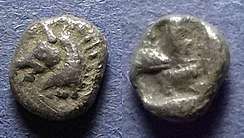Hermodike II
Hermodike II has been attributed with inventing Greek coinage, i.e. the transfer of earlier technical knowledge from Lydia into ancient Greek society through Aeolis by Aristotle.[1] Other historians have translated the name as Hermodice, Damodice or Demodike as translated by Pollux.[2]
Hermodike II was the daughter of a dynastic Agamemnon of Cyme and married to the third dynastic King Midas in the 6th Century BC.[3] She was named after Hermodike I who has been attributed with inventing the Greek written script.
Numismatic history
Coinage revolutionised trade and commerce, creating market economics, see History of coins.
A passage in Pollux speaks about those who invented the process of coining money mentioning Pheidon and Demodike from Cyme, wife of the Phrygian king, Midas, and daughter of King Agamemnon of Cyme.[4]

The 8th century BC King Midas pre-dates coinage. Coins were not invented until 610 BC by King Alyattes (610–560 BC).[5] The Lydian Lion coin directly preceded ancient Greek coinage, through which Rome begot all Western coinage. Yet, although the Lydian Lion was minted by Alyattes for use as a "nobleman's tax-token",[6] "it took some time before ancient coins were used for everyday commerce and trade. Even the smallest-denomination electrum coins, perhaps worth about a day's subsistence, would have been too valuable for buying a loaf of bread."[7] The Greeks of Cyme changed the Lydian "tax-token" into a means of transaction for the common man and woman. Stamped coins avoided weighing silver for small transactions because the symbol on the hemiobol was enough to verify its value.
Two late Greek sources record that King Midas of Phrygia married a Greek princess. Aristotle[1] calls her Hermodike and says she "cut/struck the earliest coinage of Kyme." Pollux[2] names her Demodike, the daughter of King Agamemnon of Kyme, and he notes that she was but one among several others who were alleged to have been the first to strike coins. Both sources cite Kyme in Aeolis, on the west coast of Asia minor, as the princess's home and Pollux specifically identifies her father as being king there. Given the late date (albeit derived from earlier sources) of the accounts, the fact coinage is mentioned, and that there were presumably 7th century, as well as 6th century Phrygian kings named Midas,[8] it remains uncertain that the Midas-Mita of the 8th century BC, and not a later one...[9]
However, academics state that Aristotle and Pollux, though ancient commentators, were not historians and so their unsubstantiated opinions may be misleading. Given the technological and chronological link to minting, Hermodike II may have been married to Alyattes of Lydia, who had more than one wife,[10] and who amassed great wealth, like Midas, by sourcing the electrum for his coins from Midas’ fabled river Pactolus.

Hermodike II is attributed to the global spread of coinage. The coins from Cyme, when first circulated around 600–550 BCE, utilised the symbol of the horse. The symbol of the Trojan Horse tied the dynasty of Agamemnon with the glory of the original Agamemnon through the Greek victory over Troy.
(For an excellent timeline graphic showing the progression from pre-coin, to lion, to horsehead imagery on the earliest coins, see Basic Electrum Types.[11])
...it is more likely, that what the Greeks called invention, was rather the introduction of the knowledge of them [coins] from countries more advanced in civilization.[12]
Alyattes created coinage - to use a token currency, where the value is guaranteed by the state and not by the value of the metal used in the coins[13] - and the role of Hermodike II was to communicate that technology and philosophy into Greek society as per D. Macpherson's observation,
From Aeolic Cyme a king Agamemnon married his daughter Hermodice to a Midas ruler of Phrygia. We do not know whether this was the eighth-century Midas or (if it was true that Hermodice struck the first coinage of Cyme) a later Midas ruling under Lydian or Persian authority; but some sort of Phrygia-Aeolia-Euboea link from an early period seems almost certain.[14]
Hermodike II was the royal link between Lydia and Aeolia – the conduit of knowledge and the person who influenced the Greeks into adopting the invention of coins. Ancient Greek market economics subsequently influenced the rest of the western world.
References
- Aristotle, fr.611,37 ed. V.Rose
- Pollux, Onamastikon IX.83
- The History of Antiquity, Volumes I, V. and VI of VI, Max Duncker, Library of Alexandria
- Mycenaean Origin of Greek Mythology, Martin Nilsson, 1983 Univ of California Press, p. 48.
- "World's Oldest Coin - First Coins". oldestcoins.reidgold.com.
- "World's Oldest Coin - First Coins". rg.ancients.info.
- "Hoards, Small Change, and the Origin of Coinage," Journal of the Hellenistic Studies 84 (1964), p. 89
- Herodotus I.35; Koerte 1904: 25f
- Archaeology, Artifacts and Antiquities of the Ancient Near East: Sites, Cultures, and Proveniences, Oscar White Muscarella, BRILL, 2013, p. 705
- Herodotus, The Histories, (Penguin Books, Suffolk, England, 1983), I., p. 79
- "Basic Electrum Types". www.glebecoins.net.
- Annals of Commerce, Manufactures, Fisheries, and Navigation, with Brief Notices of the Arts and Sciences Connected with Them. Containing the Commercial Transactions of the British Empire and Other Countries ... with a Large Appendix ... with a General Chronological Index ... 1805 ... by David Macpherson. In Four Volumes. Vol. 1.(–4.), Volume 1, p. 16
- Amelia Dowler, Curator, British Museum; A History of the World; http://www.bbc.co.uk/ahistoryoftheworld/objects/7cEz771FSeOLptGIElaquA
- The Cambridge Ancient History, edited by John Boederman, Cambridge University Press, 1997, p. 832